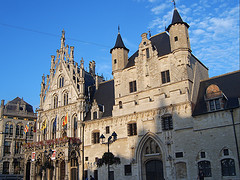
On Thursday I got a letter from the Belgian post office saying that if I didn't come to pick up my package they would send it back to the sender. Nevermind that this was the first notice I had received, I also had to go to Vilvoorde, a 45-minute train ride away, in order to get it. Now, I could probably start a separate blog and fill it with my copious complaints about the Belgian postal system! But I am learning to Belgian--patient, humble, inventive--and so I decided that I would make my visit to the completely-forgettable city of Vilvoorde more exciting by stopping off in Mechelen.
Halfway between Antwerp and Brussels, Mechelen (Malines in French) is a medieval city rich in musical history. And although one may never know it when stepping off the train today and walking straight into a row of seedy cafes (I am developing a discerning eye) and cheap clothing stores, but beyond Mechelen's suburban roads lies the well-maintained reminders of the city's rich past. In the late 15th-century Mechelen was chosen to be the home of the wealthy Burgundian court, and by 1500 the ruling ladies Margaret of York and her daughter-in-law Margaret of Austria had built up an impressive collection of music and musicians. Pierre de la Rue spent most of his working life here, and the famous printer Alamire had close ties with Mechelen. (There, after five-and-a-half blog entries I've included my first "academic adventure.") When the younger Margaret died in 1530, the Burgundian capital moved to Brussels, and Mechelen was never quite the same.
Walking through Mechelen's Grote Markt is like walking into an open-air museum. The Stadhuis (shown above) is an amazing example of unfinished architectural business. The original building, seen on the right, was severed in half by Margaret of Austria. She knocked down the part on the left and had it rebuilt in the more popular Gothic style (seen on the left.) I guess nobody thought much of her idea, because when she died the project was abandoned. Thus, what remains is one of Belgian's more striking buildings. St. Romboutskathedral is a similar hodge-podge of architectural design: the clean medieval lines of the interior is (in my opinion) marred by the tacky inclusion of Baroque statues and altars. The centerpiece of the St. R, however, is the wonderful square tower with its beautiful long and slender windows.

No comments:
Post a Comment